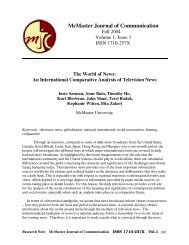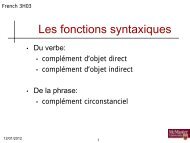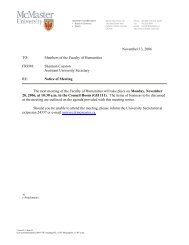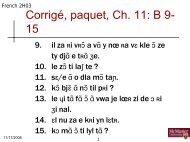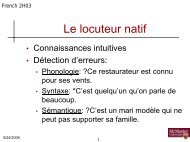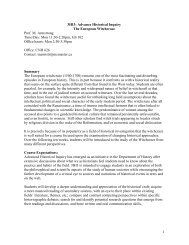The Syntax of Givenness Ivona Kucerová
The Syntax of Givenness Ivona Kucerová
The Syntax of Givenness Ivona Kucerová
Create successful ePaper yourself
Turn your PDF publications into a flip-book with our unique Google optimized e-Paper software.
(2) a. SVO: Chlapec našel lízátko.<br />
boy.Nom found lollipop.Acc<br />
(i) ‘A boy found a lollipop.’<br />
(ii) ‘<strong>The</strong> boy found a lollipop.’<br />
(iii) ‘<strong>The</strong> boy found the lollipop.’<br />
(iv) #‘A boy found the lollipop.’<br />
b. OVS: Lízátko našel chlapec.<br />
lollipop.Acc found boy.Nom<br />
‘A boy found the lollipop.’<br />
As we can see in (2-a), the SVO order in Czech is compatible with several different interpretations.<br />
<strong>The</strong> very same Czech string can correspond (i) to a situation where neither a boy,<br />
nor a lollipop are given, in the sense that there is no referent determined by the previous<br />
context, i.e., the existence <strong>of</strong> the referent has not been asserted yet; (ii) to a situation where<br />
only a boy has been previously determined by the context; or (iii) to a situation where both<br />
the boy and the lollipop have a unique referent but they have not been introduced by the<br />
previous context. Crucially, however, the SVO order is not felicitous in a situation in which<br />
only the lollipop has been introduced by the previous context, (iv).<br />
To achieve the missing interpretation, i.e., the interpretation in which only the object<br />
has been determined by the previous context, the word order must be OVS, as in (2-b),<br />
translated as ‘A boy found the lollipop.’.<br />
What is the nature <strong>of</strong> the reordering? Notice that in order to capture the intuition about<br />
meaning differences corresponding to different word orders, I used indefinite and definite<br />
articles. Since Czech does not have any overt morphological marking <strong>of</strong> definiteness – with<br />
the exception <strong>of</strong> demonstrative and deictic pronouns – we could understand the different<br />
word orders as a strategy to achieve the same interpretation that English can achieve by<br />
using overt determiners. This would be, however, a simplification. <strong>The</strong> object in the OVS<br />
order does not need to correspond to a definite description. It is enough that it has been<br />
introduced in the previous discourse, as in (3). 4<br />
(3) a. We left some cookies and lollipops in the garden for the kids. Who found a<br />
lollipop?<br />
b. Lízátko našla Maruška a Janička.<br />
lollipop.Acc found Maruška and Janička<br />
‘Little Mary and little Jane found a lollipop.’<br />
4 <strong>The</strong> reordering observed in (2-a) and (2-b) might remind the reader <strong>of</strong> the Mapping Hypothesis <strong>of</strong> Diesing<br />
1992 or <strong>of</strong> a more general discussion <strong>of</strong> specificity as in Enç 1991; van Geenhoven 1998; Farkas 2002, among<br />
many others. One might think that for a DP to become specific (whatever it means) such a DP must move to<br />
(or it must be base-generated in) a certain syntactic position. As we will see shortly, not only referential, but<br />
also predicational or propositional elements can be introduced in a discourse in the same way as the object in<br />
(2-b). I do not know at this point whether there is any connection between specificity and the data discussed<br />
here. In general, I will ignore possible relations between quantification and information structure here.<br />
7







